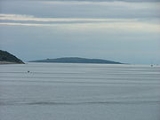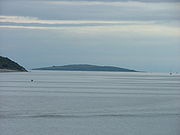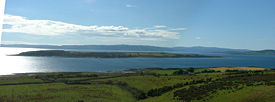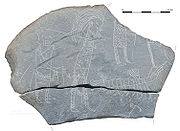
Inchmarnock
Encyclopedia
Inchmarnock is an island at the northern end of the Sound of Bute
on the west coast of Scotland
.

 Inchmarnock lies to the west of the Isle of Bute
Inchmarnock lies to the west of the Isle of Bute
at the northern end of the Sound of Bute
. It is around 3.5 kilometres (2.2 mi) long and rises to a height of 60 metres (197 ft). The island consists mainly of a single ridge running north to south. It is partially wooded and has sea caves at the north and the south and two tiny lochans inland. The island belongs to the traditional county
of Bute
and the modern unitary authority of Argyll and Bute
. It is not to be confused with Inchmarnock in Aberdeenshire. Divided into three farms, Southpark, Midpark and Northpark, only the latter is currently inhabited. A short reef of drying rocks, Tràigh na h-Uil, skirts the island's west coast.
The island gives its name to Inchmarnock Water, the body of water that lies between the island's western shore and the Kintyre
peninsula. Inchmarnock Water connects the Sound of Bute
and the Kilbrannan Sound
in the south to Loch Fyne
and the Kyles of Bute
in the north.
contains the remains of a female skeleton, the Queen of the Inch. The remains were removed for carbon dating and are now displayed behind a pane of glass in their original position.
The island's name is an anglicisation of the Gaelic Innis Mheàrnaig meaning Island of Saint Marnock. Marnock, (Old Irish M'Ernóc, 'My [ie. 'Saint'] Little Ernán) was a holy man who lived on the island in the 7th century and established a monastery. Alternatively, the name may simply be a dedication to Ernán and reflect the patron saint the monks on the island followed. He has also lent his name to a number of other locations:
The Inchmarnock Project was a study of the archaeology and history of the island from the earliest times down to the Improvements of the late 18th and early 19th centuries. It was undertaken by Headland Archaeology
and funded by Lord Smith of Kelvin, the owner of Inchmarnock. Within this long chronology of activity some periods are better represented than others, but the highlight of the project was the excavation in and around the medieval church which lies in the stack-yard at Midpark.
Excavation to the north of St Marnock's church revealed the remains of what is interpreted as an early monastic enclosure, together with a number of workshops and an exceptional number of pieces of inscribed slate
. Provisionally dated to the 8th or 9th century AD, possibly continuing later, this is the largest assemblage of such material known from Scotland. It includes examples of abstract designs and casual graffiti but also what are clearly practice pieces for the composition of more complex designs. As 'pattern books' for the creation of designs in other media, the site potentially offers the opportunity of understanding better the context in which this material was produced. Many of the slates were found in association with debris from metal-working processes.
Literacy at the site was attested by a number of fragments with practice writing, as well as one example with a piece of readable text. There are clear indications that the monks who resided on the island were teaching novices the various skills expected of young monastic scholars. Among the inscriptions are examples of Gaelic, Latin
and ogham
script. Other inscribed slates from the site provide insights into the dress, weaponry, buildings and ship technology of the time.
 Two conjoining fragments of incised slate
Two conjoining fragments of incised slate
had a particularly interesting series of images. The 'Hostage Stone' comprises a larger fragment and a smaller one, discovered in two separate seasons of excavation not far from each other. Together the piece measures 180mm by 120mm by 12mm in its current state, although it was perhaps originally slightly bigger and a portion of it may have been lost. On the face of the stone are four human figures, all facing to the right, along with a boat and a number of other miscellaneous marks. In his recent work on the excavation, Dr. Chris Lowe, the project director, indicates there has been extensive discussion on the meaning of this scene and highlights the difference in the stance and attitude of the three figures on the right of the stone compared to the one on the left. The three on the right also appear to be wearing mail armour. In this context the image appears to depict slave-raiding or hostage-taking, with the figure on the left a monk potentially being led away. An alternative interpretation is put forward by Katherine Forsyth
of the University of Glasgow
, who suggests that the scene may represent the procession of a reliquary
by an ecclesiastical figure, with the armed individuals providing protection.
The results of the Inchmarnock Project were published by Society of Antiquaries of Scotland
in September 2008.
Local legend has it that in the 19th century drunks from Rothesay
were left on Inchmarnock to dry out by means of "isolation and deprivation".
During World War II
the islanders were evacuated and the island was used for commando training.
Today, Inchmarnock is privately owned and run as an organic farm. The owner, Lord Smith of Kelvin, has introduced a population of organic Highland Cattle
, employed Headland Archaeology (UK) Ltd
to survey the island and has had a new ferry
, MV Marnock, built locally (at Ardmaleish on Bute
) to provide a service to the island.
and is a wintering ground for greylag geese
.
Sound of Bute
The Sound of Bute is a broad channel or sound separating the islands of Arran and Bute on the west coast of Scotland.The sound leads up from the lower Firth of Clyde passes the island of Inchmarnock and splits into the Kyles of Bute, Loch Fyne and round the north end of Arran into the Kilbrannan...
on the west coast of Scotland
Scotland
Scotland is a country that is part of the United Kingdom. Occupying the northern third of the island of Great Britain, it shares a border with England to the south and is bounded by the North Sea to the east, the Atlantic Ocean to the north and west, and the North Channel and Irish Sea to the...
.
Geography


Isle of Bute
Bute is an island in the Firth of Clyde in Scotland. Formerly part of the county of Buteshire, it now constitutes part of the council area of Argyll and Bute. Its resident population was 7,228 in April 2001.-Geography:...
at the northern end of the Sound of Bute
Sound of Bute
The Sound of Bute is a broad channel or sound separating the islands of Arran and Bute on the west coast of Scotland.The sound leads up from the lower Firth of Clyde passes the island of Inchmarnock and splits into the Kyles of Bute, Loch Fyne and round the north end of Arran into the Kilbrannan...
. It is around 3.5 kilometres (2.2 mi) long and rises to a height of 60 metres (197 ft). The island consists mainly of a single ridge running north to south. It is partially wooded and has sea caves at the north and the south and two tiny lochans inland. The island belongs to the traditional county
Counties of Scotland
The counties of Scotland were the principal local government divisions of Scotland until 1975. Scotland's current lieutenancy areas and registration counties are largely based on them. They are often referred to as historic counties....
of Bute
County of Bute
The County of Bute is one of the registration counties of Scotland. In 2001 its usually resident population was 13,720.-Local government county:...
and the modern unitary authority of Argyll and Bute
Argyll and Bute
Argyll and Bute is both one of 32 unitary council areas; and a Lieutenancy area in Scotland. The administrative centre for the council area is located in Lochgilphead.Argyll and Bute covers the second largest administrative area of any Scottish council...
. It is not to be confused with Inchmarnock in Aberdeenshire. Divided into three farms, Southpark, Midpark and Northpark, only the latter is currently inhabited. A short reef of drying rocks, Tràigh na h-Uil, skirts the island's west coast.
The island gives its name to Inchmarnock Water, the body of water that lies between the island's western shore and the Kintyre
Kintyre
Kintyre is a peninsula in western Scotland, in the southwest of Argyll and Bute. The region stretches approximately 30 miles , from the Mull of Kintyre in the south, to East Loch Tarbert in the north...
peninsula. Inchmarnock Water connects the Sound of Bute
Sound of Bute
The Sound of Bute is a broad channel or sound separating the islands of Arran and Bute on the west coast of Scotland.The sound leads up from the lower Firth of Clyde passes the island of Inchmarnock and splits into the Kyles of Bute, Loch Fyne and round the north end of Arran into the Kilbrannan...
and the Kilbrannan Sound
Kilbrannan Sound
Kilbrannan Sound is a marine water body that separates the Kintyre Peninsula of Scotland from the island of Arran. Kilbrannan Sound is the western arm of the Firth of Clyde.-References:...
in the south to Loch Fyne
Loch Fyne
Loch Fyne is a sea loch on the west coast of Argyll and Bute, Scotland. It extends inland from the Sound of Bute, making it the longest of the sea lochs...
and the Kyles of Bute
Kyles of Bute
The Kyles of Bute are a narrow sea channel which separates the northern end of the Isle of Bute from the Cowal peninsula, part of the Scottish mainland....
in the north.
History
At the northern end of the island a Bronze Age cistCist
A cist from ) is a small stone-built coffin-like box or ossuary used to hold the bodies of the dead. Examples can be found across Europe and in the Middle East....
contains the remains of a female skeleton, the Queen of the Inch. The remains were removed for carbon dating and are now displayed behind a pane of glass in their original position.
The island's name is an anglicisation of the Gaelic Innis Mheàrnaig meaning Island of Saint Marnock. Marnock, (Old Irish M'Ernóc, 'My [ie. 'Saint'] Little Ernán) was a holy man who lived on the island in the 7th century and established a monastery. Alternatively, the name may simply be a dedication to Ernán and reflect the patron saint the monks on the island followed. He has also lent his name to a number of other locations:
- KilmarnockKilmarnockKilmarnock is a large burgh in East Ayrshire, Scotland, with a population of 44,734. It is the second largest town in Ayrshire. The River Irvine runs through its eastern section, and the Kilmarnock Water passes through it, giving rise to the name 'Bank Street'...
, a town on the Scottish mainland - PortmarnockPortmarnockPortmarnock is a small suburban village to the north of Dublin, Ireland. It is in the administrative county of Fingal.-Location:Portmarnock lies on the coast and, owing to its proximity to Dublin city, is a form of dormitory village north-northeast of the city centre...
, a town on the eastern coast of IrelandIrelandIreland is an island to the northwest of continental Europe. It is the third-largest island in Europe and the twentieth-largest island on Earth... - DalmarnockDalmarnockDalmarnock is a district in the Scottish city of Glasgow. It is situated north of the River Clyde. It is bounded by the Clyde to the south and east, Parkhead to the north, and Bridgeton at Dunn Street to the north west...
, an area in the east end of GlasgowGlasgowGlasgow is the largest city in Scotland and third most populous in the United Kingdom. The city is situated on the River Clyde in the country's west central lowlands...
The Inchmarnock Project was a study of the archaeology and history of the island from the earliest times down to the Improvements of the late 18th and early 19th centuries. It was undertaken by Headland Archaeology
Headland Archaeology
Headland Archaeology comprises a holding company Headland Group Ltd and the trading subsidiaries Headland Archaeology Ltd, Headland Archaeology Ltd and Archaeological Investigations Ltd....
and funded by Lord Smith of Kelvin, the owner of Inchmarnock. Within this long chronology of activity some periods are better represented than others, but the highlight of the project was the excavation in and around the medieval church which lies in the stack-yard at Midpark.
Excavation to the north of St Marnock's church revealed the remains of what is interpreted as an early monastic enclosure, together with a number of workshops and an exceptional number of pieces of inscribed slate
Slate
Slate is a fine-grained, foliated, homogeneous metamorphic rock derived from an original shale-type sedimentary rock composed of clay or volcanic ash through low-grade regional metamorphism. The result is a foliated rock in which the foliation may not correspond to the original sedimentary layering...
. Provisionally dated to the 8th or 9th century AD, possibly continuing later, this is the largest assemblage of such material known from Scotland. It includes examples of abstract designs and casual graffiti but also what are clearly practice pieces for the composition of more complex designs. As 'pattern books' for the creation of designs in other media, the site potentially offers the opportunity of understanding better the context in which this material was produced. Many of the slates were found in association with debris from metal-working processes.
Literacy at the site was attested by a number of fragments with practice writing, as well as one example with a piece of readable text. There are clear indications that the monks who resided on the island were teaching novices the various skills expected of young monastic scholars. Among the inscriptions are examples of Gaelic, Latin
Latin
Latin is an Italic language originally spoken in Latium and Ancient Rome. It, along with most European languages, is a descendant of the ancient Proto-Indo-European language. Although it is considered a dead language, a number of scholars and members of the Christian clergy speak it fluently, and...
and ogham
Ogham
Ogham is an Early Medieval alphabet used primarily to write the Old Irish language, and occasionally the Brythonic language. Ogham is sometimes called the "Celtic Tree Alphabet", based on a High Medieval Bríatharogam tradition ascribing names of trees to the individual letters.There are roughly...
script. Other inscribed slates from the site provide insights into the dress, weaponry, buildings and ship technology of the time.

Slate
Slate is a fine-grained, foliated, homogeneous metamorphic rock derived from an original shale-type sedimentary rock composed of clay or volcanic ash through low-grade regional metamorphism. The result is a foliated rock in which the foliation may not correspond to the original sedimentary layering...
had a particularly interesting series of images. The 'Hostage Stone' comprises a larger fragment and a smaller one, discovered in two separate seasons of excavation not far from each other. Together the piece measures 180mm by 120mm by 12mm in its current state, although it was perhaps originally slightly bigger and a portion of it may have been lost. On the face of the stone are four human figures, all facing to the right, along with a boat and a number of other miscellaneous marks. In his recent work on the excavation, Dr. Chris Lowe, the project director, indicates there has been extensive discussion on the meaning of this scene and highlights the difference in the stance and attitude of the three figures on the right of the stone compared to the one on the left. The three on the right also appear to be wearing mail armour. In this context the image appears to depict slave-raiding or hostage-taking, with the figure on the left a monk potentially being led away. An alternative interpretation is put forward by Katherine Forsyth
Katherine Forsyth
Katherine S. Forsyth is a British historian who specializes in the history and culture of Celtic peoples during the 1st millenium AD, in particular the Picts...
of the University of Glasgow
University of Glasgow
The University of Glasgow is the fourth-oldest university in the English-speaking world and one of Scotland's four ancient universities. Located in Glasgow, the university was founded in 1451 and is presently one of seventeen British higher education institutions ranked amongst the top 100 of the...
, who suggests that the scene may represent the procession of a reliquary
Reliquary
A reliquary is a container for relics. These may be the physical remains of saints, such as bones, pieces of clothing, or some object associated with saints or other religious figures...
by an ecclesiastical figure, with the armed individuals providing protection.
The results of the Inchmarnock Project were published by Society of Antiquaries of Scotland
Society of Antiquaries of Scotland
The Society of Antiquaries of Scotland is the senior antiquarian body in Scotland, with its headquarters in the National Museum, Chambers Street, Edinburgh...
in September 2008.
Local legend has it that in the 19th century drunks from Rothesay
Rothesay, Argyll and Bute
The town of Rothesay is the principal town on the Isle of Bute, in the council area of Argyll and Bute, Scotland. It can be reached by ferry from Wemyss Bay which offers an onward rail link to Glasgow. At the centre of the town is Rothesay Castle, a ruined castle which dates back to the 13th...
were left on Inchmarnock to dry out by means of "isolation and deprivation".
During World War II
World War II
World War II, or the Second World War , was a global conflict lasting from 1939 to 1945, involving most of the world's nations—including all of the great powers—eventually forming two opposing military alliances: the Allies and the Axis...
the islanders were evacuated and the island was used for commando training.
Today, Inchmarnock is privately owned and run as an organic farm. The owner, Lord Smith of Kelvin, has introduced a population of organic Highland Cattle
Highland cattle
Highland cattle or kyloe are a Scottish breed of beef cattle with long horns and long wavy coats which are coloured black, brindled, red, yellow or dun....
, employed Headland Archaeology (UK) Ltd
Headland Archaeology
Headland Archaeology comprises a holding company Headland Group Ltd and the trading subsidiaries Headland Archaeology Ltd, Headland Archaeology Ltd and Archaeological Investigations Ltd....
to survey the island and has had a new ferry
Ferry
A ferry is a form of transportation, usually a boat, but sometimes a ship, used to carry primarily passengers, and sometimes vehicles and cargo as well, across a body of water. Most ferries operate on regular, frequent, return services...
, MV Marnock, built locally (at Ardmaleish on Bute
Isle of Bute
Bute is an island in the Firth of Clyde in Scotland. Formerly part of the county of Buteshire, it now constitutes part of the council area of Argyll and Bute. Its resident population was 7,228 in April 2001.-Geography:...
) to provide a service to the island.
Wildlife
Inchmarnock is home to the largest colony of herring gulls in the Firth of ClydeFirth of Clyde
The Firth of Clyde forms a large area of coastal water, sheltered from the Atlantic Ocean by the Kintyre peninsula which encloses the outer firth in Argyll and Ayrshire, Scotland. The Kilbrannan Sound is a large arm of the Firth of Clyde, separating the Kintyre Peninsula from the Isle of Arran.At...
and is a wintering ground for greylag geese
Greylag Goose
The Greylag Goose , Anser anser, is a bird with a wide range in the Old World. It is the type species of the genus Anser....
.

